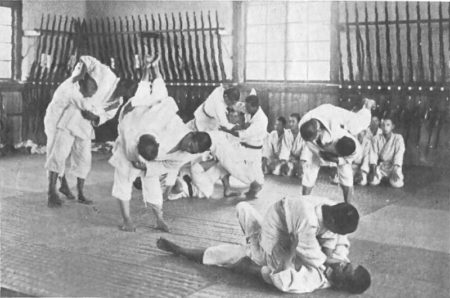通販の柔術 1921
1月に広告が印刷されました 16, 1921 のエディション ST. ルイ·ポストディスパッチ advertising a mail order course on Jujitsu from Capt. アラン・スミス. CAPT. スミスはもともとスコットランドで生まれましたが、日本の柔術のデモンストレーションに魅了されました (実は柔道) 彼はイギリスで見た. Smith traveled to Japan with a company and learned Judo reaching 1st degree black belt.
Smith would travel to the United States a few years later and start teaching these techniques to the U.S. Army. Smith also began selling a mail order course, a fairly common practice among wrestlers and physical culturists.

Jujitsu Practice at a Japanese Agricultural School in 1922 (パブリックドメイン)
Smith’s advertisement claimed after you learned the tricks and secrets of Jujitsu, you could easily defeat a giant. Women could overcome any ruffian using 100 percent of their strength against 20 percent of the attacker’s strength. Smith’s ad also claimed his instruction of the art was superior because Japanese teachers did not explain why a trick or technique worked. Smith did explain the “tricks”.
“The Secrets of Jujitsu” book contained 59 lessons with 253 illustrations. Interest students didn’t have to send any money to receive the course. They only had to mail the coupon to Stahara Publishing Company in Columbus, Georgia.
The student had 5 days to review the material and either send it back or send $5.00 in full payment. で 2020 dollars, the course would cost 71 dollars. Quite reasonable to become invincible.
CAPT. Smith’s ad was representative of a certain type of marketing, which was popular during the 20th Century. Mail order courses for just about anything were common in every magazine and newspaper. They were loaded with lots of wild claims about beating up a bully, developing large muscles or becoming a millionaire. We don’t see many of these ads anymore because of truth in advertising laws.
I can’t if Capt. Smith was doing the advertising or his publisher. I hadn’t heard of Capt. Smith until I found this ad, while researching Jujitsu fighter competing against professional wrestlers.
In reality, almost all of these early “柔術” fighters were Kodokan black belts sent out by Jigaro Kano to spread Judo. Jujitsu teachers didn’t share their knowledge freely. 博士. Kano was an exception. CAPT. Smith was a Judo black belt, who traveled to the United States to spread the art.
Since paid fighting was banned by the Kodokan, it could be the fighers used Jujitsu to try and stay out of trouble with the Kodokan. More likely, the terms Judo and Jujitsu were used interchangeably at the time.
Judo was new, while Jujitsu was more established in Japan. So much exaggeration and hyperbole exist around most martial arts history, it is difficult to know the real reasons behind a practice.
You can leave a comment or ask a question about this or any post on my Facebookページ.
Sources: ST. ルイ·ポストディスパッチ, 1月 16, 1921 edition, P. 93 と Journal of Non-Lethal Combatives, 6月 2003.
Pin It

